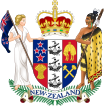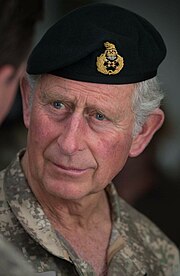Head of the Armed Forces (New Zealand)
| Head of the Armed Forces | |
|---|---|
 | |
| New Zealand Defence Forces | |
| Style | His Majesty |
The Head of the Armed Forces is a position held ex officio by the monarch of New Zealand, Charles III.[1] In this role the monarch promotes and commemorates the history and service of New Zealand Defence Force.[2][3] The monarch also serves as the locus of fealty in the New Zealand Defence Force's oath of allegiance.[4]
While Elizabeth II was the Head of the Armed Forces, she assumed the role of colonel-in-chief for several New Zealand military units.[3]
The King's representative in New Zealand, the governor-general, holds the title of Commander-in-Chief and is constitutionally the supreme authority in defence matters in New Zealand.
Commander-in-Chief
The King's representative in New Zealand, the governor-general, is also called the Commander-in-Chief of New Zealand, and is constitutionally the supreme authority in defence matters in New Zealand.[5] The title is not considered a separate position from the governor-general, with the "Governor-General and Commander-in-Chief" being considered the compounded title of the office. However, except in formal circumstances, only one of the titles is used, with the title of commander-in-chief being used in contexts associated with the armed forces.[6]
In practice, the role of the commander-in-chief is ceremonial, with the governor-general serving as a "patron of the New Zealand Defence Force".[7] The governor-general exercises their authority as commander-in-chief on the advice of the minister of defence or other ministers of the New Zealand Government.[5][8] The minister of defence is provided the power of control over the Defence Force on behalf of the Government and exercises this power through their primary military advisor, the Chief of Defence Force.[9]
History
Governors in New Zealand were vested with the requisite powers to raise armed forces as early as the 1860s. On at least one occasion, during the Second Taranaki War, the governor of New Zealand had to take personal command of military forces. The governor of New Zealand was first designated the commander-in-chief in legislation passed in 1865, providing him the authority to raise forces and call upon them. Defence legislation enacted in New Zealand since 1865 has perpetuated the statutory provision that vested these powers to the governor-general.[6] It remains in Defence Act 1990 under sections five and six.[10]
The governor-general and commander-in-chief were constituted into a single office through the Letters Patent Constituting the Office of Governor-General of New Zealand in 1983. The Letter Patent also provided the office with all other prerogative powers relating to the armed forces.[6][11] The Defence Act 1990 also expressly protects these powers against suppression by legislation.[6]
References
- ^ @nzdefenceforce (14 September 2022). "With the accession of His Majesty King Charles III, our Royal New Zealand Navy fleet units receive a designation change" – via Instagram.
- ^ "Address to His Majesty King Charles III—Condolences on Death of Her Majesty Queen Elizabeth II and Congratulations on Accession to Throne". www.parliament.nz. 13 September 2022. Retrieved 7 December 2023.
- ^ a b "New Zealand". www.royal.uk. The Royal Household. Archived from the original on 1 October 2022. Retrieved 10 May 2023.
- ^ "Defence Regulations 1990 (SR 1990/78) (as at 13 September 2014) 3 Oath of allegiance – New Zealand Legislation". www.legislation.govt.nz.
- ^ a b "Page 3. Governance of the New Zealand armed forces". Teara.govt.nz. New Zealand Government. 1 April 2020. Retrieved 7 December 2023.
- ^ a b c d McLean, Janet; Quentin-Baxter, Alison (2017). This Realm of New Zealand The Sovereign, the Governor-General, the Crown. Auckland University Press. ISBN 9781775589631.
- ^ "The Governor-General's role as Commander-in-Chief". Gg.govt.nz. New Zealand Government. 10 December 2007. Retrieved 10 May 2022.
- ^ "Defence Act 1990". Legislation.govt.nz. New Zealand Government. Retrieved 7 December 2023.
- ^ "2023 Briefing to Incoming Ministers of Defence" (PDF). www.beehive.govt.nz. New Zealand Government. 2023. p. 4. Retrieved 8 December 2023.
- ^ "Review of the Performance of the Defence Force in Relation to Expected Standards of Behaviour, and in Particular the Leaking and Inappropriate Use of Information by Defence Force Personnel". Publicservice.govt.nz. Te Kawa Mataaho Public Service Commission. 16 July 2002. Retrieved 7 December 2023.
- ^ "Letters Patent Constituting the Office of Governor-General of New Zealand". Legislation.govt.nz. New Zealand Government. Retrieved 7 December 2023.
